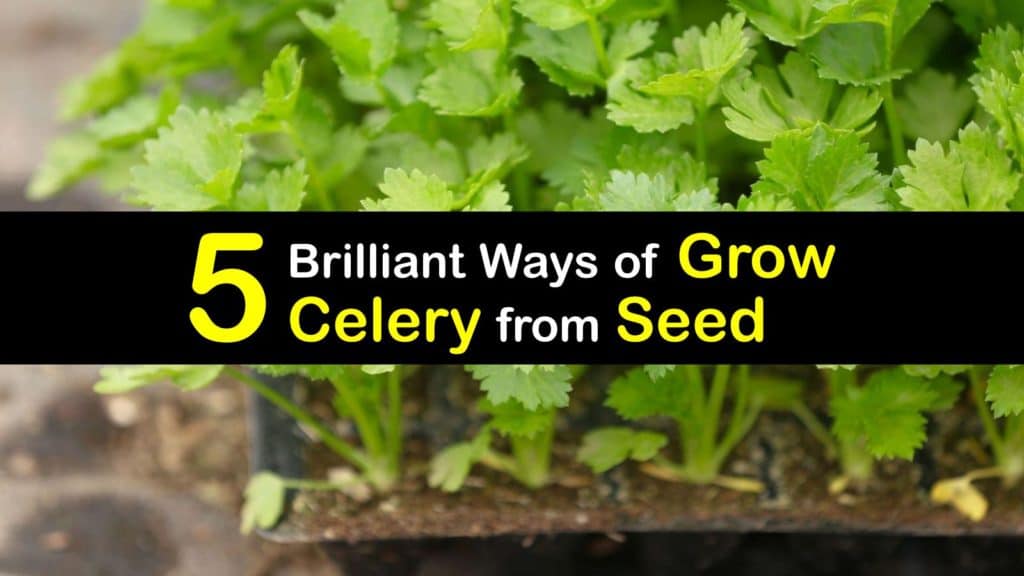Growing celery from seed has numerous benefits. Homegrown celery tastes better than store-bought, and you also have the peace of mind of knowing that your produce is free from harmful pesticides and other chemicals. Read on to find out how to grow celery from seed and keep it thriving in your garden.
Celery is a cool weather crop with a long growing season. The average time from planting celery seeds to harvest is 98-130 days. For this reason, most gardeners start celery seeds in the early spring, about six to ten weeks before the average last frost date.
Despite its reputation of being difficult to grow, celery makes an excellent addition to your veggie garden. Learn to grow your own groceries following our best gardening tips.

Growing Celery from Seed is Easy
Celery, or Apium graveolens, is a biennial plant. Whether you grow celery from scraps or seeds, the plant directs its energy toward the leaves, stems, and roots during the first year.
The following year, it flowers and produces seeds. However, most gardeners plant celery as an annual crop to harvest the crisp stalks. There are two main celery varieties in USA: trenching and self-blanching.
Trenching celery requires light deprivation to produce pale stalks like what you see in the grocery store.
Once the plants reach about 12 inches tall, gradually mound the soil around the plant, adding several inches every few days until it nearly touches the leaves. Alternatively, wrap the plant in thick paper or cardboard.
Self-blanching celery doesn’t require light deprivation. The advantage to blanching celery is that the stalks taste sweeter and are more tender. However, depriving the plants of chlorophyll reduces the amount of vitamins present.
Celeriac, or knob celery, is a particular variety that forms a large, round edible root. Celery root is eaten cooked or raw and is rich in fiber, vitamins, and minerals.

How to Grow Celery from Seed
Like when you plant carrot seeds, celery seeds are tiny, but it’s imperative not to plant more than four seeds per cell. Otherwise, the seedlings grow too close together and become stunted. The same applies as the way to grow cabbage from seed and many other vegetables, as well.
For a fall harvest, start celery seeds 12-14 weeks before the average first frost. Transplant the seedlings outdoors once daytime temperatures are consistently below 80℉.
When you grow vegetables indoors, dip a damp cotton swab in the seeds and scrape them off with a toothpick to help control seed dispersal. Loosely fill the tray with seed starting potting mix, when you grow turnips from seed, celery, or another favorite veggie.
Sprinkle three or four celery seeds per cell, and don’t press the seeds down or cover them. Mist the tray to lightly saturate the soil.
Celery seeds typically take one to three weeks to germinate. For faster germination, soak the seeds in warm water overnight before planting. Cover the tray using a humidity dome or plastic wrap to hold in moisture.
When considering how to sprout celery seeds or if you plant kale seeds, warmth is one of the most critical factors. What month do you plant celery? It depends on where you live.
The ideal soil temperature for germinating celery seeds is between 70-75℉. The top of the refrigerator usually works, or use a heat mat to keep the soil consistently warm.
How to Sprout Celery Seedlings
Once your seedlings sprout, move the tray to a sunny, south-facing windowsill with at least six hours of direct sunlight daily. Encourage strong stems by turning the tray every few days so the seedlings lean away from the window.
To prevent the celery seedlings from becoming elongated or “leggy,” consider using a grow light to supplement natural sunshine.
Once the seedlings reach two inches tall, transplant them to individual peat pots. Keep the soil consistently moist, and maintain an air temperature of 70-75℉ during the day and 60-65℉ at night.
When to Transplant Celery Seedlings Outdoors
Begin hardening off your celery seedlings two weeks before transplanting. Set them outdoors in a sheltered area progressively longer each day to acclimatize them.
To prevent your seedlings from bolting, wait one week after the average last frost date before transplanting. The soil temperature should be around 50℉, with nighttime temperatures above 40℉.
Celery needs full sun, plenty of water, and nutrient-rich soil. One week before transplanting, work several inches of compost into the garden bed. For blanching celery using the mounding method, plant seedlings in 12-inch deep trenches.
Add two tablespoons of all-purpose organic fertilizer to the bottom of the hole when transplanting your celery seedlings. Used coffee grounds and eggshells are excellent natural amendments that also help deter slugs.
Coffee grounds provide nitrogen, and eggshells add calcium to the soil. Fertilize your celery plants once per month throughout the growing season.
Ensure the plants get enough water, as celery stalks become withered and stringy if they dry out. Add mulch to retain moisture, keep the roots cool, and suppress weeds.
Harvest celery stalks as needed from the outside of the plant. Or, harvest the entire plant at once in late summer for a spring-planted crop or in fall to early winter for a late-season crop. Always use a clean, sharp knife when harvesting celery.
Celery leaves are also edible and have a strong flavor. Use the dark green outer leaves cooked in soups, stews, and sauces. The light green inner leaves have a milder flavor and a tender texture for eating raw in salads or using as a garnish.
If you don’t have the garden space, there is a way to grow celery in a pot, too. Follow the same guidelines for sun, soil, water, and fertilizer.
Companion Plants for Celery
Companion planting is a garden design technique that utilizes plants’ unique properties to attract beneficial insects, repel pests, and enrich the garden ecosystem. However, some plants are not compatible and should grow in separate areas.
Aromatic herbs like dill, oregano, rosemary, thyme, and sage attract pollinators and beneficial predatory insects to the garden. They also repel common pests like aphids, cabbage loopers, spider mites, and whiteflies, in addition to deer and rabbits.
Alliums like garlic, onions, and chives repel insect pests, rodents, and deer. They also give celery a sweeter flavor when grown nearby.
Flowers like nasturtiums and geraniums repel celery worms, flea beetles, and cabbage loopers. They also act as a trap plant for aphids to keep them from feeding on the celery plants.
It’s beneficial to grow celery near brassicas like cabbage, kale, radishes, turnips, and broccoli as well as bush beans and cucumbers. Celery repels cabbage moths and whiteflies.
Avoid planting celery seeds close to carrots, parsnips, and parsley. Being in the same family as celery, they suffer from similar pests and diseases and compete for the same nutrients and root space.
Common Pest and Disease Problems with Celery Plants
The most common insects that attack celery plants are aphids, cabbage loopers, celery worms, spider mites, and slugs. Use row covers to protect your seedlings after transplanting.
If you notice insect damage on the leaves or stalks, spray all parts of the plant with insecticidal soap or neem oil. Leaf spot is one of the most frequent fungal diseases that affect celery plants. Yellow patches appear on the leaves that later turn brown or grey.
Spores spread through splashing water, insect activity, and contaminated garden tools. Use a copper fungicide to treat leaf spot fungus after removing the diseased plant matter.
Don’t compost the affected plant material, as insect eggs and fungal spores sometimes overwinter in compost. To avoid spreading disease, use drip irrigation and be sure to clean your tools after each use.
Instead of purchasing organic celery from the grocery store, why not try growing your own? Homegrown celery tastes better and has more nutrients than the store-bought veggie.
Start celery seeds indoors in March, and follow the gardening tips listed above for how to sprout celery seedlings. After the last danger of frost, plant celery in an area that receives full sun, plenty of water, and has soil rich in organic matter.

If you enjoyed learning about how to grow celery from seed, please share this article about growing celery from seed with your fellow gardeners on Pinterest and Facebook.